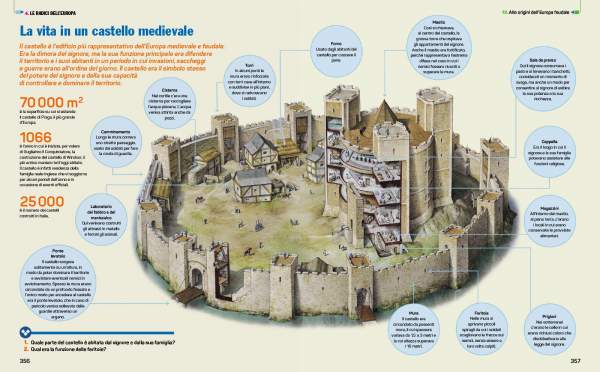To illustrate the military strength of the Byzantine Empire during the High Middle Ages, DeA Scuola joined together the materials of two infographics in volume ITACA 2. One of the infographics shows a cataphract, the Byzantine horseman of heavy cavalry, which illustrated the power of ground forces; the other infographic presents the dromone, the bireme galley, showing the maritime power of the Byzantine sovereigns until year 1000.
Page(s): 232-233

Under the title of Le case dei Romani (The houses of the Romans) on volume ITACA 2: Viaggio nella Geostoria: Dall'Impero romano all'Alto Medioevo (Journey through Geohistory: From the Roman Empire to the High Middle Ages), DeA Scuola used the infographic The Roman City to illustrate the way of life in Rome during the imperial period.
Page(s): 70-71

The infographic of the Roman aqueduct was part of the pages that volume ITACA 2: Viaggio nella Geostoria: Dall'Impero romano all'Alto Medioevo (Journey through Geohistory: From the Roman Empire to the High Middle Ages) dedicated to Roman civilization. ITACA volumes are an innovation in the shared use of the classic book on paper, adding the advantages provided by new information technologies. Volume ITACA 2 was the continuation of volume ITACA 1: Viaggio nella Geostoria: Dalla Preistoria all'Impero romano. DeA Scuola completed the image dedicated to the Roman engineering work, with the characteristics of the Trajan aqueduct, which is the longest of the eleven that in the 2nd century supplied water to the capital of the empire; DeA Scuola also included other elements unrelated to the original infographic.
Page(s): 48-49

The extensive treatment that volume ITACA 2 of DeA Scuola gives to the High Middle Ages practically forces to visually illustrate the way of life of a typical family during that period of western history, when the most of the population worked in field. Unlike others, the original infographic did not show changes in its page layout.
Page(s): 306-307

In the chapters dedicated to the High Middle Ages, volume ITACA 2 included this image of the medieval castle to show how people lived in that period, inside these fortified enclosures, which proliferated in Europe from the 9th century.
Page(s): 356-357

In volume ITACA 1, of the DeA Scuola project, the infographic Le fortezze celtiche (The Celtic castra) was also inserted as didactic material to exemplify the lifestyle of other European societies, besides the Greek and Roman ones.
Page(s): 314-315

In volume ITACA 1, DeA Scuola also dealt, with the infographic Le scienze applicate (Applied sciences), on the technology developed in Hellenistic Greece, with some well-known examples: the pulley set, the crane, the hydraulic pump and the Archimedean screw; besides the rudiments of the steam engine, developed by Hero of Alexandria.
Page(s): 236-237

Of course, infographics also have application in teaching materials. Such is the case of the ITACA educational project, carried out by DeA Scuola. The teaching division of the Italian publisher DeAgostini has conceived, on paper and on electronic media, an innovative textbook that allows online interaction. In the first volume, ITACA 1: Viaggio nella Geostoria : Dalla Preistoria all'Impero Romano (Journey through Geohistory : From Prehistory to the Roman Empire), three infographics appeared. The first one was dedicated to the Greek hoplites, whose effective combat system was applied since the 8th century B.C., throughout all antiquity.
Page(s): 158-159

Copyright © 2025
Designed by Sol90 S.L
